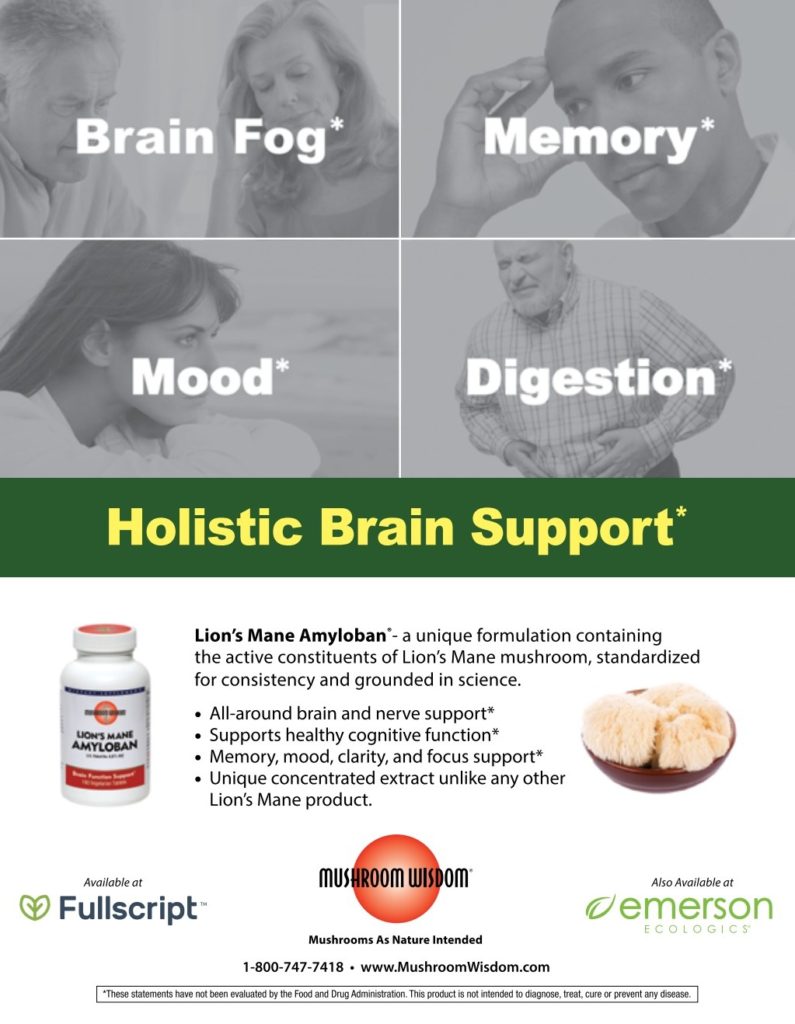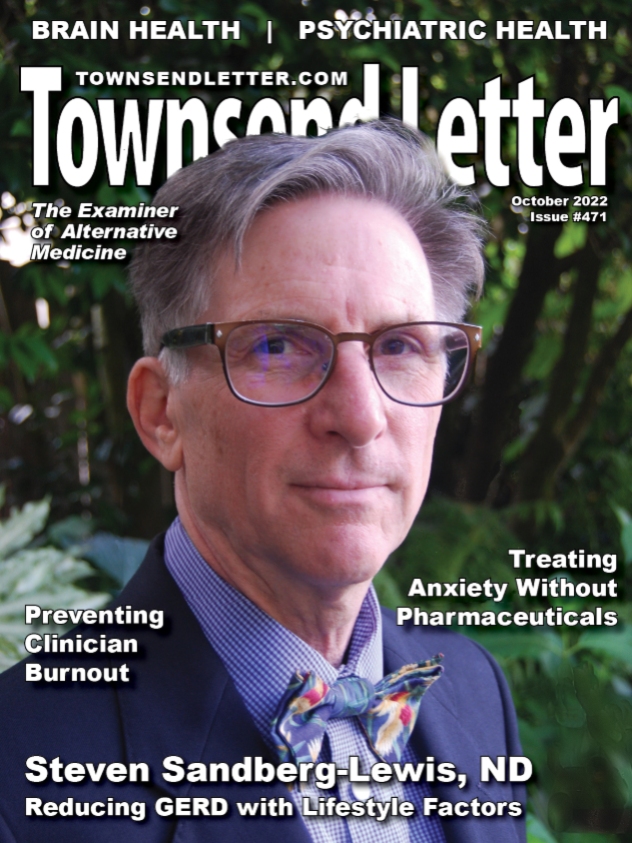By Sarah A. LoBisco, ND, IFMCP
Essential Oils for Enhanced Treatment Outcomes

Essential oils are a passion of mine…and of the mind. Plentiful animal and in-vitro studies, along with many accumulating human trials have shown their ability to simultaneously modulate emotions, brain wave patterns, neurochemistry, physiology, and biochemistry. This is an amazing feat not often seen with conventionally based applications.1-25
Due to their multifaceted properties, essential oils bridge the link between the mind and body. They are synergistic with many integrative and conventional treatments based on their influence on one’s mindset, mood, and biology. Various types of studies have demonstrated essential oils’ ability to modulate emotional patterns and promote mindfulness, as they enhance outcomes by removing psychological blocks to healing. 1-2, 5-6,12-25 I have found them to be extremely helpful in assisting clients to break through the fears, struggles, and setbacks that often arise when moving forward to create a new reality as a healed individual.
In previous articles in this journal, I have reviewed the cellular mechanistic pathways, emotional and cognitive processing effects, and functional applications of essential oils.1-2 These intricate particulars may have left the reader appreciative of essential oils’ prowess yet desiring more concise examples on how they could implement them into their clinical practice.
For this reason, in this article, I will be moving away from emphasizing the theoretical. Rather, I wish to demonstrate how I incorporate essential oils into my practice through a case study. I will provide this as an example on how they can be incorporated into any holistic and integrative treatment approach.
I have aimed to exclude extraneous particulars of other interventions and details on lab work for the case. This was intentional to focus more succinctly on essential oils as an imperative intervention.
As with any functional or naturopathic doctor, it is rare to have a sole modality for any complex issue. This holds true for essential oils. Therefore, before I discuss the case, I will review a few important and practical considerations any practitioner or consumer should be aware of when implementing essential oils with other healing protocols.
Considerations for Clinical Use of Essential Oils
Address the Root Cause. As I mentioned in my previous article, “Exploring the Complexities and Caveats of Safe Internal Use of Essential Oils for Pain: Highlighting Intestinal Discomfort, Part 2,” “[b]efore selecting a therapeutic modality of any kind, it is important to address the underlying cause and use a naturopathic and functional medicine approach to address it.”2
Understanding one’s full health history, pertinent labs, and assessing any triggers, mediators, and antecedents of the current health issue is imperative to fully address any disease process or symptom.
Although many consumers are using essential oils for general health, as practitioners we have the capability to boost their efficacy for our clientele. This can be accomplished by selecting an essential oil in a category that addresses the causative factors and complements our other interventions.
For example, lavender often works well for anxiety and sleep,6,14 yet if someone hates the smell of lavender flowers it will result in a more jarring reaction than a calming one. Perhaps in this case, we have done our due diligence and understand that the underlying issue for this person’s anxiety is based on an inability to focus and lack of energy, not a nervous system hyperarousal.
In this scenario, along with considering appropriate hormonal, neurotransmitter, digestive, oxidative stress, mitochondrial, and lifestyle support, we may be apt for selecting peppermint essential oil. This oil would help to alleviate the lethargy and cognitive fatigue that manifests into this type of anxiousness. 3-6
You just can’t get that preciseness from general consumer training, right!?
Be Aware of Biochemical Individuality and Essential Oils Properties. As noted above, aromas possess qualities that are pleasing or displeasing to an individual based on their prior associations of that smell. Beyond this, everyone’s unique biochemical and microbiome signature interacts with the hundreds of different molecules in one drop of essential oil. This means responses may vary.1
Based on this individual variability, some may do better with different essential oils in a category. This “matching game” makes essential oils an art and science. For example, if someone is not responding to lavender, other calming oils to consider include the following:
- Citrus oils, such as lemon, lime, and orange, which are soothing to the mind, boost mood, and enhance focus;
- Bergamot, which calms anxiety, assists with inflammation, and can abate nervous system overwhelm.15-17
Most essential oil companies have a basic “starter kit” that contains some of the most popular essential oils. You can use them to guide you in selecting which oils you may wish to begin working with. They also provide blends in the kit that are self-explanatory. I like “Stress Relief” and “Peaceful” blends.
I also offer a free database of essential oils that reviews the properties of single oils and contains various uses of essential oils in specific health categories. These articles offer scientific reviews, consumer tips, and applications. They can be found at https://dr-lobisco.com/essential-oils-database.
Biochemical individuality makes using essential oils empowering because patients must participate in their healthcare and be mindful on how different essential oils impact their wellbeing and symptoms.
The good news is that essential oils are very forgiving based on their synergism and overall makeup. Rather than acting solely on one chemical pathway or cascade using one isolated compound, for the most part, generalized, positive effects are often observed.1-26 This means that even if an essential oil isn’t an exact match, it will likely still produce a beneficial effect.
You Don’t Have to Start Off Being an Expert, But Be Mindful of the Basics. Overall, essential oils are extraordinarily safe and exit the body quite quickly with no negative effects on the microbiome.1-2 Still, there are some general safety things to be aware of.
As a rule, it is good to space essential oils away from medications, about 1-2 hours, and monitor effects as you would with any other intervention. 1-2
If you are not comfortable with internal usage of essential oils, start with topical applications. About 2-4 drops twice a day, diluted in about 1 tsp of an organic fatty oil, is a good place to start. This is based on a 2-5% dilution rate. (Please see my previous article, “Exploring the Complexities and Caveats of Safe Internal Use of Essential Oils for Pain: Highlighting Intestinal Discomfort, Part 2,” for more details on dilution ratios.) Begin with just 1-2 drops in this carrier oil base if one is new to essential oils.
When assessing for feedback, listen to your patient, believe them, and learn from them about their experience with all essential oils.
Quality Counts. Quality matters… a lot. Just as with supplements, you won’t get as good results from essential oils labeled as “organic, pure” essential oil as you would from essential oils that are third-party tested for active constituents and have extensive quality and manufacturing standards. Unfortunately, standards and quality are not monitored with essential oils in the United States so one truly has to get to know their supplier and do their homework.
You can read more about this and see examples of tests that a manufacturer may require to ensure quality in “Exploring the Complexities and Caveats of Safe Internal Use of Essential Oils for Pain: Highlighting Intestinal Discomfort, Part 1.”2 I also have articles for quality on my database.
Now we are ready for the case study.
Annie’s Courageous Story
One of my clients, “Annie,” came to me because she was unsuccessfully “coping” with anxious feelings. She was very concerned with the repercussions. Lately she noticed she was drinking more than she wanted to and felt that the effects of her “off mood” and wine intake were impacting her, her career, and her family. Annie found that she wasn’t engaging as much as she’d like to with her husband and two small children, aged five and nine years old.
Annie’s sleep had been poor, with some late-night awakenings that she attributed to stress with subsequent rumination. She also noted she wasn’t as focused and productive at work. She admitted that she may be using alcohol to soothe uncomfortable feelings. She was hoping to find an alternative to calm her down so she could stop reaching for wine at the end of every day.
Annie had been experiencing extreme anxiety for over a year now but reported that she had always had a nervous disposition since childhood. Last year she had been prescribed antidepressants and benzodiazepines by her primary care doctor. At that time, she felt her anxiety was at a point that it was taking over her life. The antidepressant, Effexor, caused her to be more “jittery” and the benzodiazepine made her feel “out of it.” She was also nervous of their side effects and feared getting dependent on them. Annie was aware she could not mix them with alcohol.
Annie’s open-minded physician suggested that Annie try some “natural, herbal support,” because they weren’t getting anywhere. Annie remained determined to find safe relief and sought me out after she spoke with a friend who was a current client.
Annie and I had an instant connection. She courageously opened up to me about her past history, which contained some trauma. We discussed how her exposure to her mom’s excess prenatal stress hormones, in combination with her genetics and turbulent childhood, set her up to be more vulnerable to the stressors of life. I explained to her how some of her symptoms were likely linked to prenatal and adverse childhood events. These contributed to her more sensitive and “nervous predisposition” and they may put her at greater risk for physical health imbalances if not addressed.27
I told Annie I didn’t think we would get very far if we couldn’t calm down her brain and allow for her nervous system and adrenal glands to relax a bit from excreting excess stress hormones. I suggested several mind-body options, including yoga, breathing exercises, Emotional Freedom Technique (EFT), and HeartMath to assist her in processing and dealing with her emotions constructively.27-28 I also suggested she seek out cognitive behavioral therapy.
Annie rarely reached out for support or took downtime for herself. I explained to her that self-care and supportive relationships were important components in healing. I also emphasized how isolation and loneliness can put her more at risk for mental and physical health ramifications.29-30
To effectively support Annie’s mind, body, and emotions through her changes, I introduced her to essential oils.1-25, 30-31 We discussed the instantaneous shift in her mood that could occur with a single inhalation and the additive impact of the volatile compounds in plants.1-2
Annie was grateful for all the information and felt hopeful.
Essential Oils Formulations for Annie
The following are the essential oils mixtures I suggested for Annie within two visits.
An essential oil blend that included 1-2 drops each of ylang ylang, lavender, and orange oil. This blend would be supportive in modulating nervous system tone and assisting with promoting a calm, cheerful mood.
Ylang ylang was used because it has been studied to enhance the parasympathetic nervous system and modulate heart rate, which is often impacted by stress and anxiety. Its aroma is thought to induce feelings of confidence and self-esteem,20-22 which is something that I felt would benefit Annie.
Lavender is the “universal oil” for calming the nerves, assisting with anxiety, and addressing sleep issues. 1-2, 5-6, 14
Orange oil is uplifting to the mood, assists with focus, and has many wellness benefits due to its high limonene content.13-14 Note: citrus oils can be photosensitizing so only apply them to areas that are not exposed to direct sunlight.32-33
Application: Annie was instructed to inhale the oil blend from the cup of her hand and apply it twice a day over her heart. The oils were to be mixed in 1 tsp of organic coconut or jojoba oil.

Note: If Annie had sensitive skin, she could bypass her chest and apply the oils to the bottoms of her feet first. The bottoms of the feet are the least sensitive area of the body and a good place to start if someone has sensitive skin. Essential oils are lipid soluble and do enter circulation topically, regardless of where they are applied.1-2
Joyful oil blend from my favorite manufacturer that could be diffused in her home daily for 3-8 hours.
The Joyful blend contains many oils that fit well with Annie’s symptom picture:
- Bergamot peel oil (Furocoumarin-free) to soothe anxiety and support the mind-body.15-17
- Ylang ylang flower for balancing the cardiovascular and nervous systems.20-22
- Rose Geranium flower oil for its hormonal and mood balancing properties.19,34
- Lemon peel oil which has a refreshing scent that invigorates.23-24
- Coriander seed oil which contains compounds that have been found to be calming and promote a positive mind-gut connection.35-36
- Tangerine peel oil, another citrus oil to promote happiness and focus.23-24
- Jasmine oil which has been shown to balance the brain’s electrophysiology and calm stress.12
- Roman chamomile flower oil to enhance calmness of the mind and support overall health.37-38
- Palmarosa oil for general overall wellness enhancement.39
- Rose flower oil to inspire romance, connection, joy, and healthy hormonal output.19,34, 40-41
Application: I suggested an atomizer diffuser, which keeps all essential oil compounds intact. The directions were to place 8-10 drops of the Joyful blend a day in the diffuser and to fill it with filtered or distilled water. It could be run on intermittent speed for 3-8 hours a day.
Finally, we also discovered that Annie’s estrogen and serotonin levels needed support based on her serum blood markers and a urinary metabolite panel she had previously done with her open-minded primary care doctor.
Along with nutrition to support her borderline low iron levels and B12 (high Methylmalonic Acid, MMA), and herbals to balance her stress response (Bacopa and Eleuthero), we added another oil blend.
The last blend contained 2 parts clary sage and geranium to 1 part neroli. Clary sage has been shown in a small trial to modulate cortisol and serotonin.18
Geranium has been shown to help balance the mood and in one small trial it impacted estrogen levels favorably. 19
Neroli is a beautiful scent that has an anxiety relieving effect. A small trial concluded it assisted with anxiety-induced crack withdrawal.23-25Although Annie didn’t have cocaine issues, the modulating of anxiety-based substance use was important
Applications: I asked Annie to apply this blend to her ankles in her preferred organic carrier oil in the morning and in the evening. The ankles are an area that I was taught by holistic healers to have benefit for hormonal issues. I was not able to substantiate this claim, but I have followed it with good results.
Annie’s Wellness Protocol Instructions
I told Annie to start with the essential oils, calming procedures, and sleep hygiene. After noticing any changes, in a week, she could introduce the herbals and nutritional support one at a time. This spacing allowed Annie to experience how each intervention separately had a subtle or powerful impact.
I also encouraged her to eat at regular intervals to balance her blood sugar and combine a good quality protein, fat, and carbohydrate with every meal to prevent hypoglycemic dips. Annie was not someone in which dietary restriction would serve.
Annie checked-in a few times within the next few months to discuss progress, work out stumbling blocks, and assist with implementation.
The Six-Month Follow Up
When Annie returned a few months later, she had nourished her body and mind and had more fully, gained awareness of the mind-body connection. When given natural alternatives to manage stress and anxiety, she had stopped drinking regularly. She was able to honor her emotions without needing to suppress them!
Today, she can have an occasional wine and stop after one. She uses her mind-body practices to help her stay centered and soothed. She will not go anywhere without applying her oils. She especially noted positive effects from the Joyful and “Happy Hormone” blend. Annie discovered a side benefit as well. She noticed straight away that diffusing that combination of oils in the Joyful blend not only uplifted her, but also her whole household.
She is now living a happier, calmer life. This is reward enough, but there was a bonus…she gave me flowers from the garden she started!
Concluding Remarks
Prescribing an antidepressant or treating Annie’s drinking as an “addiction” would have missed the mark in this case. Here is an example of someone who lacked self-care resources and was using a substance to sooth hypersensitivity to stress hormones and an endocrine imbalance.
When given a mood balancing medication that also increased norepinephrine, it made symptoms worse.
In this case, we looked at the root cause, addressed the imbalances, and gave her new tools to help her navigate her emotions in a more constructive way. Essential oils were key factors to this transformation that assisted with her psychology as we modulated her physiology.
In a few months, Annie and I will likely adjust her essential oils formulations, as I like to change oils as one’s biological and emotional health shifts. In the meantime, Annie and I are thrilled with how well she’s doing.
This is just one example of why I feel essential oils are my “secret sauce” to better patient outcomes and happier clients.
Sarah Lobisco, ND, IFMCP is a graduate of the University of Bridgeport’s College of Naturopathic Medicine (UBCNM). She is licensed in Vermont as a naturopathic doctor and has earned her certification in functional medicine through the Institute of Functional Medicine (IFM). Dr. LoBisco also holds a Bachelor of Psychology from State University of New York at Geneseo and an Applied Kinesiology certification.
She is a speaker on integrative health, has several publications, and does independent contracting for companies regarding supplements, nutraceuticals, essential oils, and medical foods. Dr. LoBisco currently incorporates her training as a naturopathic doctor and functional medicine practitioner through writing, teaching, private practice, and through her independent contracting work. She maintains her private wellness consultation practice through virtual consultations. Dr. LoBisco also enjoys continuing to educate and empower her readers through her blogs and social media. Her recent blog can be found at dr-lobisco.com.













